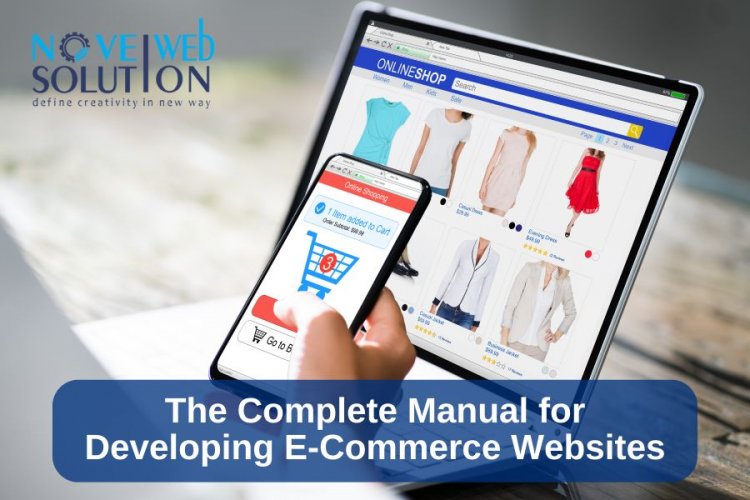The Complete Manual for Developing E-Commerce Websites

The e-commerce landscape is booming, offering unprecedented opportunities for businesses to reach a global audience. Developing an effective e-commerce website is crucial for tapping into this potential. The Complete Manual for Developing E-Commerce Websites, from planning and design to development and marketing.
Planning Your E-Commerce Website
To develop an e-commerce website, first identify your business goals, such as increasing sales, enhancing customer engagement, or building brand awareness. Analyze your target audience's demographics and behaviors to tailor your site to their needs effectively. Conduct thorough market research to understand competitors and identify market gaps that your e-commerce site can fill. Choose the right e-commerce platform, such as Shopify, WooCommerce, or Meesho, based on factors like scalability, customization options, and ease of use. Each platform has its strengths and weaknesses, so choose one that aligns with your business needs and technical capabilities. Budgeting for website development, hosting, marketing, and maintenance is crucial to allocate resources effectively. Factor in costs for additional features, plugins, and potential future expansions.
Designing Your E-Commerce Website
User Experience (UX) Design
A user-friendly website is crucial for retaining customers. Ensure intuitive navigation, easy-to-find products, and a seamless shopping experience. Accessibility is also vital, making your site usable for all visitors, including those with disabilities.
Visual Design and Branding
Your website’s design should reflect your brand identity. Consistent use of colors, fonts, and imagery helps create a cohesive brand image. Invest in designing an attractive homepage and detailed product pages to captivate your audience.
Mobile Responsiveness
With the increasing use of mobile devices for online shopping, ensuring your website is mobile-friendly is essential. A mobile-first design approach can enhance user experience and improve SEO (Search Engine Optimization) rankings.
SEO-Friendly Design
Optimize your website for search engines from the outset. Implement best practices for on-page SEO, such as using relevant keywords, optimizing images, and improving site speed. A fast, responsive website will rank higher and attract more visitors.
Developing Your E-Commerce Website
Setting Up Your Domain and Hosting
Choose a reliable hosting services provider to ensure your website’s performance and security. Secure your domain name and install SSL certificates to protect customer data and build trust.
Installing and Configuring Your E-Commerce Platform
Follow a step-by-step guide to install your chosen e-commerce platform. Configure essential settings, and install necessary plugins and extensions to enhance functionality.
Product Catalog Management
Organize your product catalog effectively. Use clear categories and attributes to help customers find products easily. Write compelling product descriptions and use high-quality images to showcase your offerings.
Shopping Cart and Checkout Process
Design a seamless shopping cart experience with clear calls to action. Implement a secure and efficient checkout system to minimize cart abandonment and enhance customer satisfaction.
Integrating Payment and Shipping Solutions
Payment Gateways
Integrate popular payment gateways like PayPal, Stripe, and Square. Providing different payment choices helps boost conversion rates.Ensure all transactions are secure with SSL certificates.
Shipping Methods and Logistics
Set up shipping zones and rates to manage logistics efficiently. Partner with reputable shipping companies to ensure prompt delivery. Implement systems to manage inventory and order fulfillment smoothly.
Ensuring Security and Compliance
To ensure data protection and privacy, businesses should adhere to GDPR and CCPA regulations, implement privacy policies, and provide customer information. Regular security audits, firewalls, anti-malware tools, and staff education on best practices are essential for preventing breaches.
Marketing and Promoting Your E-Commerce Website
Search Engine Optimization (SEO)
Implement off-page SEO strategies such as backlinking and guest posting. Utilize local SEO to target specific regions and increase visibility in local searches.
Content Marketing
Create compelling content to attract and keep consumers. Use blogs, videos, and social media to share valuable information and drive traffic. Develop email marketing campaigns to keep customers informed and engaged.
Paid Advertising
Leverage Google Ads, Facebook Ads, and other Pay-Per-Click management for campaigns to reach a broader audience. Use retargeting strategies to convert visitors who have shown interest in your products.
Post-Launch Strategies
To improve website performance, set up Google Analytics and other tracking tools to analyze user behavior, traffic sources, and sales data. Implement live chat and support ticket systems to promptly address customer inquiries and provide excellent customer service. Continuously test and optimize your website through A/B testing to identify pain points and areas for enhancement, keeping it competitive and user-friendly.
Conclusion
ecommerce website development company in jaipur requires careful planning, attention to detail, and ongoing maintenance to ensure its success. By following this complete manual, you'll be well on your way to creating a professional and profitable online store that will help your business thrive in the digital marketplace.






